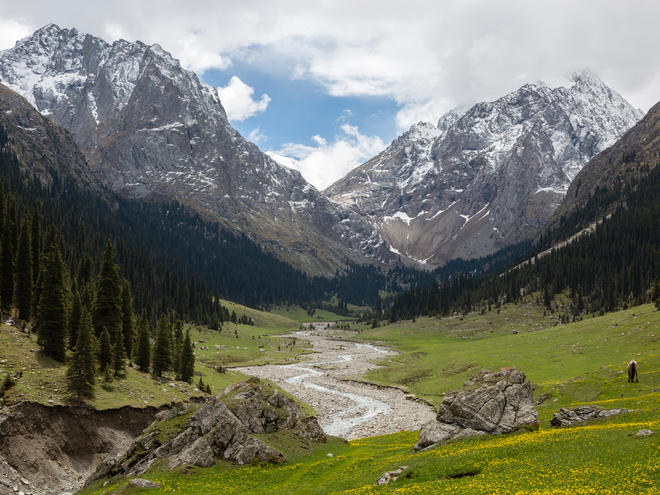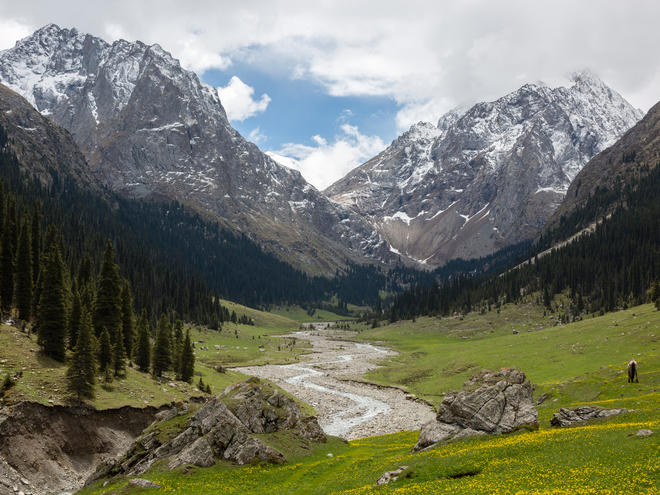Changing people and landscapes: Farida’s story
Published by the World Wildlife Fund

The village of Ak-Shyrak, Kyrgyzstan is special to Farida Balbakova. But just in her lifetime, the village has gone through enormous changes. In her youth, it was under Soviet Rule and all property was government-owned. In 1991, the Soviet Union collapsed and Farida watched as her countrymen lost their livelihoods and living conditions deteriorated. Soviet mining operations had ceased, so many chose to breed cattle. But others followed an unlawful path: Poaching snow leopards became a popular occupation.
Corruption made once protected areas vulnerable. Land was sold with unlimited rights for hunting endangered animals, including snow leopards, mountain goats and sheep. The high mountains, once thriving for people and nature, were dying.
Farida remembers spending many sleepless nights contemplating the deforestation, disappearance of animals, and degradation of pastures across the newly independent Kyrgyzstan’s various elevations and habitats. “I felt as if the land was asking,” she says,” ‘Please save me.'”
She recognized that to change people’s behavior, she had to change their thinking. “I realized,” she recalls, “it was first necessary for the villagers to see that the Earth was theirs to protect—that it belongs to them.”
In Ak-Shyrak and other similar, isolated mountain villages, Farida started holding conservation workshops for adults. She organized children’s theater productions full of skits and songs about biodiversity. She also organized games and festivals around events like Forest Day. She persistently worked with government officials, rallied supporters, delivered petitions, wrote letters, and engaged media. Though threatened with arrest, she refused to give up.
Over the years, her work paid off. Farida convinced officials to view environmental impacts differently and understand the challenges associated with habitat loss and climate change. Poachers shifted from hunting snow leopards to protecting them as park rangers. Herders embraced more sustainable practices. Women began crafting and selling eco-friendly goods. And the children lead a range of festivities for Snow Leopard Day.
Kyrgyzstan is not the only country with villages like Ak-Shyrak. Asia’s high mountains stretch across 12 countries, each with remote mountaintop villages perched on the edge of snow leopard habitat, the border of what’s livable for human beings, and the front lines of climate change.
These mountains are also known as the Third Pole and host the headwaters of rivers that sustain millions of people. Protecting high mountain cultures, waterways, and the elusive snow leopards of these transboundary ecosystems requires getting nations—even traditional adversaries—to collaborate.
In October 2012, WWF launched the USAID-funded Conservation and Adaptation in Asia’s High Mountain Landscapes and Communities project to promote conservation of snow leopards and their habitat; improve water security; design and implement community climate change adaptation strategies; and foster sustainable natural resource management and development at local, national, and regional levels in snow leopard range areas.
In Kyrgyzstan, the community based conservation activities led by Farida have paved the way for an integrated, climate-smart landscape management plan to protect the snow leopard. Currently under development, this landscape plan will be a model for other landscapes identified by the transboundary Global Snow Leopard and Ecosystem Protection Program (GSLEP).
If other countries can create similar landscape management plans, an arch of climate-smart adaptation may stretch across Asia’s high mountains. Empowering villagers, using climate science to secure entire landscapes for people and nature, and bringing traditional adversaries together over the iconic snow leopard feels like a momentus task. But as Farida has proven, people have the power to change landscapes.
Read the full article at: http://feedproxy.google.com/~r/WWFStories/~3/X-LNmjR03vk/changing-people-and-landscapes-farida-s-story


